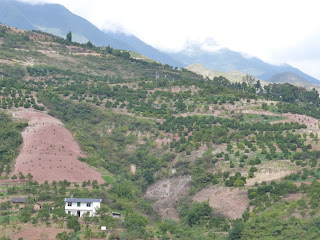Today proved to be the most spectacular day for scenic cruising. During the morning we travelled through Wu (Witches) Gorge. Lush, mist-enshrouded mountains, including the legendary Twelve Peaks, rose up on both sides.
Wu (Witches) Gorge is perhaps the most beautiful, noted for its magnificent scenery of lush green mountains that are often shrouded in mist. The river's currents shift and change constantly as it roars through the gorge, and Wu was once as dangerous to navigators as it was beautiful. Here are the Twelve Peaks including the beautiful Shennu Feng ("Goddess Peak") topped by a naturally sculptured rock resembling a maiden looking down at the river. Set picturesquely amidst these peaks is the town of Wushan, which looks over both the Yangtze and its Daning River tributary.
Some of the hundreds of photos taken today. They do not do justice to the breathtaking beauty.
Steps up to a temple. Only a small portion is shown in this photo. A popular tourist area.
The Lesser Three Gorges lie on the Daning River. Narrower than the Great Three Gorges, these remarkable canyons are equally impressive. Sheer cliffs and steep mountains rise on either side and clear water flows between towering speaks covered with lush greenery. There are also a number of historical sites, including the hanging coffins of the Ba people and the ancient plank road carved into the cliff side. This plank road consists of more than 6,000 holes, about two inches in circumference carved by hand into the side of the cliffs. Wooden stakes inserted into the holes supported bamboo pipes to carry brine and planks that created a road stretching more than 60 miles along the river.
The Lesser Three Gorges are already benefiting from the building of the Three Gorges Dam; the river has always been extremely shallow, in some places only inches deep, and one could explore than only up to a certain point. Rising water levels mean that the traditional sampans can now push further up the Daning to enjoy more of the beauty of the Lesser Three Gorges.
When we arrived at Wushan, we were transferred to smaller sightseeing vessels for our trip up the Lesser Three Gorges on the Daning River. Our large ship could not navigate these waters. Our local guide pointed out all the points of interest.
Our cute little sightseeing vessels with our local Chinese guide
The much narrower Daning River, the Lesser Three Gorges
Yup, this appears to be a bathroom with Western toilets, minus doors
Once again, just a few of the many photos we took on our sail through Qutang Gorge
On the top deck, enjoying a lovely warm, sunny day
After the gorges, the landscape remained rugged, but quite agricultural. Orange trees grow anywhere they can. There were many small towns, shrines and temples along the river.
Orange groves
Shrine
More orange groves
Another temple
The end of the Three Gorges

















































